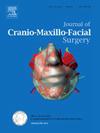使用患者特异性植入物对左1号截骨术准确性的三维评估。
IF 2.1
2区 医学
Q2 DENTISTRY, ORAL SURGERY & MEDICINE
引用次数: 0
摘要
本研究评估了LeFort 1型截骨术中上颌不同位置患者特异性种植体(PSI)的准确性。12例患者采用PSIs和手术指南行LeFort 1截骨术。计算了A点、中上切牙点、犬齿尖和第一磨牙中颊尖在三个轴上的计划位置与实际位置之间的偏差。分析采用Spearman’s Rho、Friedman和Wilcoxon检验,并采用Bonferroni校正。LeFort 1手术中上颌运动平均中外侧为1.46±0.09 mm,正前方为3.75±0.23 mm,上下方为1.08±0.17 mm。平均偏移量分别为0.41±0.03 mm(中外侧)、0.60±0.14 mm(正后侧)和0.45±0.15 mm(上后侧)。计划运动与A点(上下端,P = 0.022)和左第一磨牙(中外侧,P = 0.045)偏差呈负相关。后牙在上下方向的偏差(0.62±0.42 mm)高于前牙(0.34±0.30 mm) (P = 0.007)。PSI技术确保前牙的理想垂直位置的良好转移。小的前垂直和后横向运动比大的相同区域和轴的运动更容易出现偏差。本文章由计算机程序翻译,如有差异,请以英文原文为准。
A three – dimensional assessment of the accuracy of lefort 1 osteotomy using patient specific implants
This study evaluated patient specific implant (PSI) accuracy at different maxillary locations during LeFort 1 osteotomy. Twelve patients underwent LeFort 1 osteotomy using PSIs and surgical guides. Deviations between the planned and actual positions were calculated for point A, mid-upper-incisal point, canine cusps, and first molar mesiobuccal cusps across the three axes. Spearman's Rho, Friedman, and Wilcoxon Tests with Bonferroni correction were used for analyses. Maxillary movements in LeFort 1 surgery averaged 1,46 ± 0,09 mm mediolaterally, 3,75 ± 0,23 mm anteroposteriorly, and 1,08 ± 0,17 mm superoinferiorly. The average amounts of deviations were 0,41 ± 0,03 mm (mediolateral), 0,60 ± 0,14 mm (anteroposterior), and 0,45 ± 0,15 mm (superoinferior). Negative correlations existed between planned movement and deviation at point A (superoinferior, P = 0.022) and left first molar (mediolateral, P = 0.045). Posterior teeth showed higher deviations (0.62 ± 0.42 mm) than anterior teeth (0.34 ± 0.30 mm) in the superoinferior direction (P = 0.007). The PSI technique ensures excellent transfer of the desired vertical position of the anterior teeth. Small anterior vertical and posterior transverse movements are more prone to deviations than great movements in the same regions and axes.
求助全文
通过发布文献求助,成功后即可免费获取论文全文。
去求助
来源期刊
CiteScore
5.20
自引率
22.60%
发文量
117
审稿时长
70 days
期刊介绍:
The Journal of Cranio-Maxillofacial Surgery publishes articles covering all aspects of surgery of the head, face and jaw. Specific topics covered recently have included:
• Distraction osteogenesis
• Synthetic bone substitutes
• Fibroblast growth factors
• Fetal wound healing
• Skull base surgery
• Computer-assisted surgery
• Vascularized bone grafts

 求助内容:
求助内容: 应助结果提醒方式:
应助结果提醒方式:


